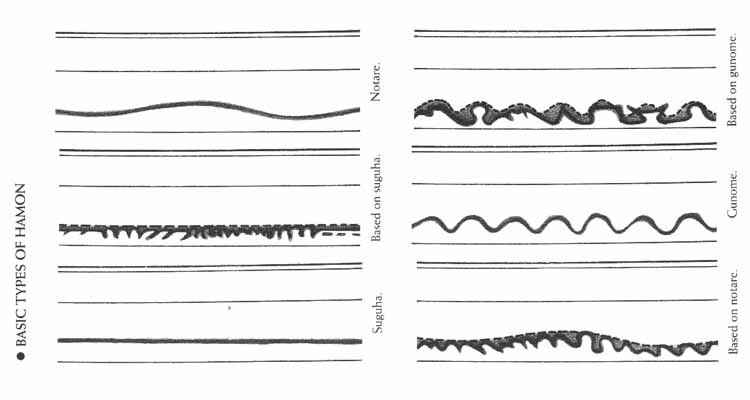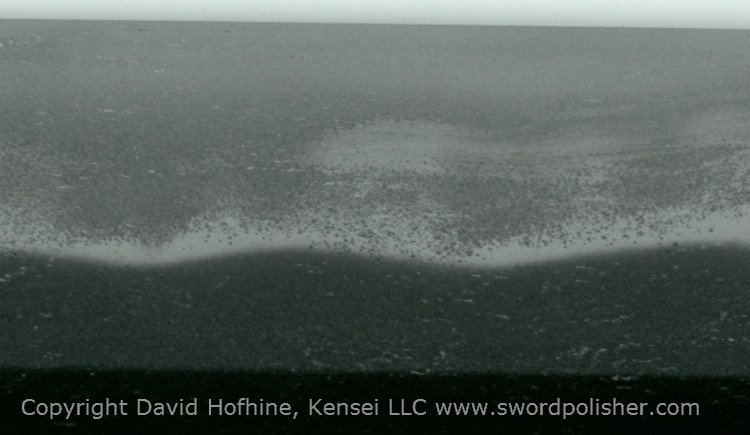Japanese
Art Sword Finish
Polishing
Keisho or
Sashikomi Finish?
www.swordpolish.com
| |||||||||||||
|
Light Keisho |
There
are 2 types of finish polish that can be applied to the hamon
(temper line) of a Japanese sword, KEISHO (pictured left and above) and
SASHIKOMI (pictured right). Keisho translates as "made up"
and involves
taking a stone called hadori and whitening the area that makes up the
shape of the hamon. Sashikomi is an older natural style of
polish that
uses special tsuya stones and nugui to make the hamon stand out on its
own without additional stone work. When to choose keisho: A keisho finish will work well with most Japanese swords. Some people do not like keisho because when it is done poorly it can hide the details of the hamon or if it is done in a lazy manner and does not follow the true hamon closely, it can obscure large portions of the ji (body). When it is done well it will actually enhance the visibility of the crystalline structures without masking any of the ji (see photo at top of page). I always strive to do a light and very detailed keisho that evokes the natural beauty and features of the hamon. Keisho is by far the most common type of finish done in Japan today. Most swords seen in fine sword books have a keisho finish. In the majority of cases a modern polish should be done in keisho style. If you are planning to submit a blade for shinsa, it should probably have a keisho finish. There are some blades where a sashikomi finish is most appropriate. If the blade has a hamon that is a very light and wispy nioi deki, sashikomi may be preferable as a keisho polish may wash out the details. If the blade has a hamon such as sanbon-sugi or some togari-ba, a sashikomi finish may also be preferable. This is because the hamon consisting of many narrow, high, widely separated peaks, may not fit well into a keisho wave form as pictured below. Hitatsura (full temper) blades are usually done in sashikomi style as there is no discrete area to apply hadori stones. There are cases where sashikomi can not be done. Some blades have an extremely hard hamon that will appear shiny rather than whitish in sashikomi style. Some have an incomplete hamon, core steel coming through, loose welds, etc. Any flaws in the blade will be clearly visible and possibly even emphasized with a sashikomi style finish. A keisho style finish allows the polisher to use different stones and techniques on the body and edge steel. This allows a great deal of latitude for hiding irregularities in the body or filling in gaps in the hamon as each surface can be worked separately to its best advantage.  | Sashikomi |
|||||||||||
 |
|||||||||||||
- Why Choose DAVE?
- HOME
- Kensei LLC News Page
- Recent Work
- Before and After
- Sword Polishing Pictures
- Original Art
- Why is the waiting list so long?
- Keisho or Sashikomi finish?
- Complete service and price listing
- Packaging and Shipping
- World Senbongiri Record Broken!
- Judo Photos
- Ghost Sword, Download free sample chapters 1-3
 Photostream
for
David Hofhine
Photostream
for
David Hofhine Facebook for
David Hofhine's Kensei LLC
Facebook for
David Hofhine's Kensei LLC- Need Help with selling a sword?
Please feel free to contact me at the following address:
E-mail:davidhofhine@gmail.com
Copyright Kensei LLC


